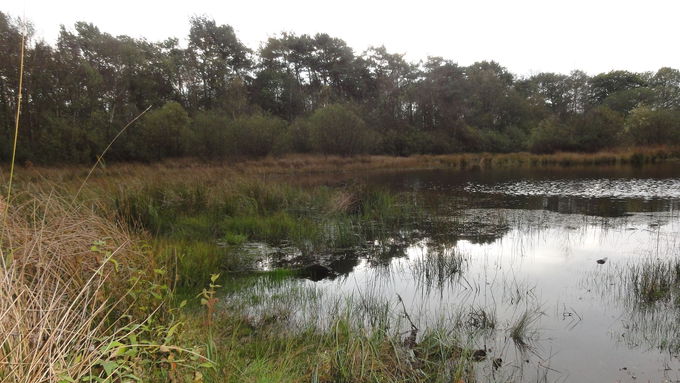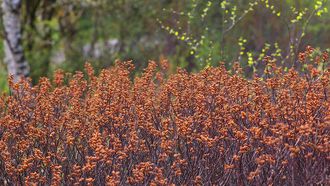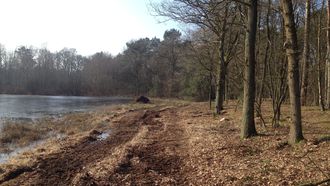View from the north bank of the heath pond towards the east © Bezirksregierung Münster
download picturemain content
Project of the month
#2/2018 ‘HANFTEICH’ IN SAERBECK
Optimization of habitat for the floating water-plantain, the crested newt, and the moor frog
The area ‘Hanfteich’ southeasterly of the municipality of Saerbeck is about 5.6 ha in size. It has been put under nature protection already in 1938 and thereby is Saerbeck’s oldest nature reserve and one of the oldest within the district of Steinfurt.
The Hanfteich is a shallow heath pond, as they once were common in the sandy areas of the Westphalian Bay. It was formerly used for “roasting” hemp: Hemp bundles were stored in the water for several days so that the fibres could be better detached from the stipes. The shallow lake is surrounded by copse and small areas with deciduous and pine forests in the midst of an agricultural landscape. In years with low rainfall, the water dries out largely.
Since 2010, the core area, which is 4.4 ha in size, has the status of a Special Area of Conservation (SAC) as part of the Natura 2000 network of nature protection areas across the European Union, due to the state-wide importance of its sphagnum moss and fen vegetation.
The designation as SAC particularly occurred for the habitat type "oligotrophic to mesotrophic standing waters with vegetation of the Littorelletea uniflorae and/or of the Isoeto-Nanojuncetea" (3130) and for three species protected by the Habitats Directive: the crested newt (Triturus cristatus), the moor frog (Rana arvalis) and the floating water-plantain (Luronium natans). But there are also many other threatened and endangered species, such as the bog-myrtle (Myrica gale), the marsh St. John's wort (Hypericum elodes), the slender sedge (Carex lasiocarpa) and the translucent stonewort (Nitella translucens).
In the 1970s and perhaps until the early 1980s, this heath pond was also home to one of the largest populations of the common spadefoot in the Münsterland. In most cases, surveys in Westphalia found only populations with up to ten calling males; in Hanfteich, up to 40 callers were registered though in the spring of 1972. However, since the early 1970s, the suitability as spawning waters for the common spadefoot increasingly deteriorated by heavy silting, so that in April 1987 only up to ten calling males were confirmed. An extensive desludging carried out towards the end of the 1980s was not successful in preventing the extinction of this population.
About 30 years after this major restoration effort, the growth of trees and eutrophication are again negatively affecting the suitability as habitat for the occurring rare and endangered species and the valuable nutrient-poor watersides. In particular, willow bushes and alder buckthorns have spread on some stretches of the heath pond; birches, alders and pines grow adjacently. The neighbouring, very shallow waterbody, which had been excavated in the late 1980s north of the nature reserve, is eutrophied by foliage entry and shaded by willow bushes as well. For this reason, this LIFE IP action is to clear the banks of the heath pond and the adjacent small waterbody from woody plants as far as possible.
The aim of these interventions is to improve the conservation status of the habitat type "oligotrophic to mesotrophic standing waters with vegetation of the Littorelletea uniflorae and/or of the Isoeto-Nanojuncetea" (3130) and the LIFE IP focus species occurring there. In addition, other resident species such as Eurasian teal (Anas crecca) and black stork (Ciconia nigra) will benefit from this action. It is important to keep the waterside areas clear, especially of willow, birch and alder, to prevent the input of leaves and nitrogen, while the bog-myrtle must be preserved. The resulting wood is removed from the protected area. To carry out these woodland works, it is necessary to create access roads to the area. These will be closed again after completion of all work.
In a second step, the northern, southern and south-eastern waterside areas of the heath pond will be desludged in late summer or autumn when the weather is dry, ensuring that the soil is not extracted too deep and only the mud layer is removed. The soil of the adjoining waterbody shall be stripped very flat to reach the seed bank with the seeds of dwarf rush (Juncus capitatus) and sand rush (Juncus tenageia) and uncover them. The woodwork in the area started at the end of January 2018. Further earthworks shall take place in August/ September.
The SAC Hanfteich is under constant control and supervision of the Lower Nature Conservation Authority of the District of Steinfurt and the Biological Station of the District of Steinfurt, which also carry out the site supervision during the implementation of this action.
Related topics
additional information
Further Links
- Special Area of Conservation „Hanfteich“ – State Agency for Nature, Environment and Consumer Protection (LANUV NRW) (in German) (external link opens in a new window)
- Nature Reserve “Hanfteich” - State Agency dor Nature, Environment and Consumer Protection (LANUV NRW) (in German) (external link opens in a new window)
- Biological Station of the District of Steinfurt (in German) (external link opens in a new window)
- District of Steinfurt – Division Nature and Landscape (in German) (external link opens in a new window)






